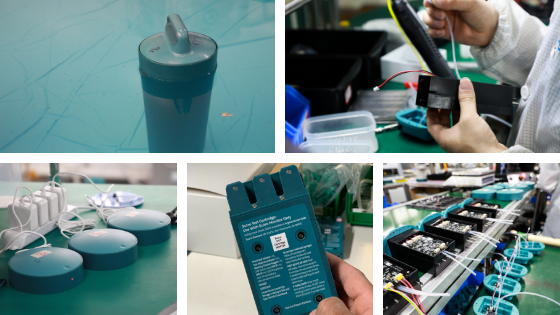I came up with the idea for Sutro based on my experience working in my dad’s pool business. It was obvious to me, since I worked at it daily, that testing pool and spa water was a major pain. We would have countless customers come into our shop asking us to test their water. It was clear that it was one of the hardest things to get right and even harder to do consistently.
Learning Can Sometimes be Painful
Sutro’s first attempt at a smart monitor was back in 2015. We designed a product that was similar to what’s out on the market now — glass-bulb-based testing. I won’t bore you with a big technical rant on that. Let’s just say that the painful lesson we learned is that glass-bulb-based testing has a horrendous drift problem. That drift causes the results to vary over time, greatly — thus making it impossible to provide an accurate recommendation. Garbage in equals garbage out.
That’s why we choose to use reagent based testing for our new design. Reagent-based testing using reagents or chemicals to turn the water different colors. If you have used a Drop Based Test Kit where you drop reagents into water from little bottles, then you have been doing reagent based testing like we do.
Reagent Based Testing is the Gold Standard
Our reagent-based testing technology is based on our partner’s, LaMotte, 100 years of experience. LaMotte’s testing technology is used to determine the quality of drinking water since it’s the most accurate and repeatable method out there. The other advantage of reagent-based testing is that drift is nonexistent since each and every batch of reagents is testing to a standard and certification. Since our Smart Monitor uses about a cartridge of reagents each month, this ensures the most accurate results. We want to make 100% sure that the readings we send to our recommendation engine are as accurate as possible. Think of our Smart Monitor as a little floating water lab that uses the same method that the EPA uses to ensure drinking water is safe.
It All Starts With (Potential) Customers
Back in 2015, we made another mistake in designing our monitor that turned out to be on par with the glass bulb design decision — not getting early and frequent feedback from customers.
The culture in Silicon Valley is one of moving fast and breaking things. Most technical founders, myself included, figure that with whatever whizbang gizmo we could invent, our customers would be overjoyed. I mean, testing pools and spas is a major reason customers would come into my dad’s shop. Heck, I was a pool boy with an engineering degree and I hated it. What could go wrong?
The problem with designing anything is that we make a lot of assumptions that seem reasonable but end up taking you down endless rabbit holes. Two of the most painful rabbit holes were pool chemical calculators and determining which pool and hot tub chemicals people use to treat their water.
Pool Chemical Calculators
The heart of any good pool monitoring system is its pool chemical calculator or, what we call, our recommendations engine. Pool water testing is complex in that there are so many variables impacting a pool’s pH level, Free Chlorine, and Total Alkalinity. When those values are outside an optimum range, the results are cloudy water or green water, among other things. On top of that, it’s hard to test a recommendation engine given variables such as pool size, water-based chemistry, and geographic location.
